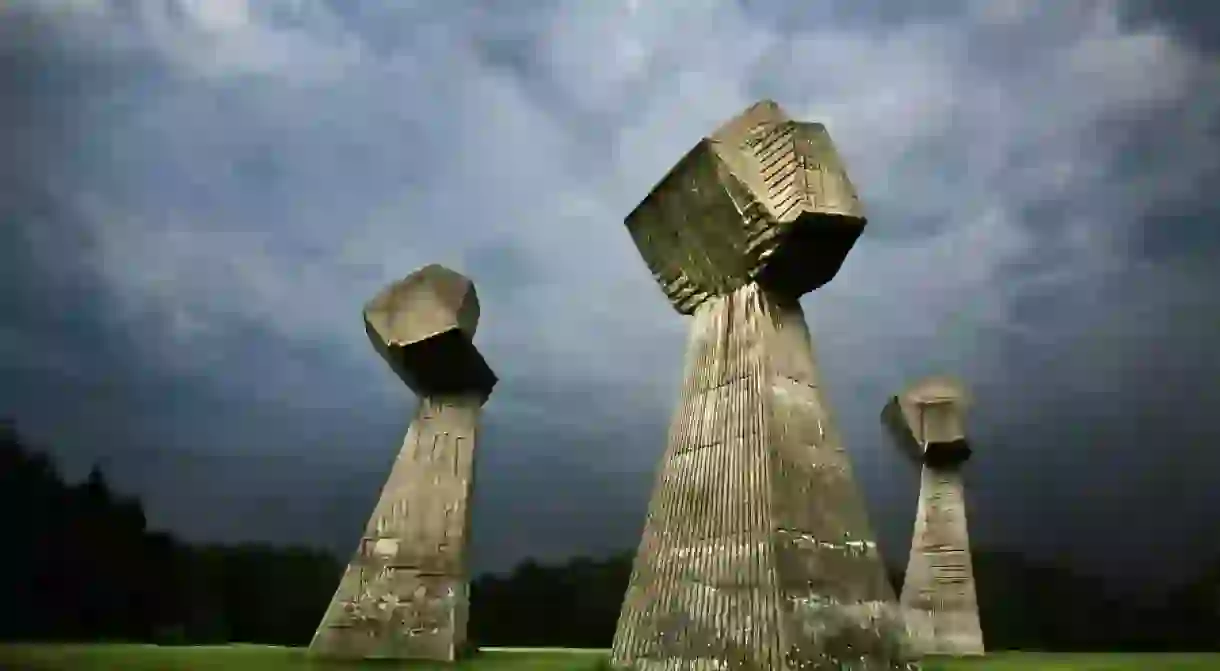The Most Impressive Second World War Monuments in Serbia

Yugoslavia was ripped apart by a three-way conflict during World War II, which ended with the communist Partisans victorious. Josip Broz Tito commissioned many monuments to be built in honour of those who fell in the war, a collection of obelisks unlike anything else on the planet. These are the finest memorials in Serbia.
Kosmaj
One of the two Belgrade mountains, Kosmaj is home to the highest point in the area around the capital. It was also the location of one of the most striking monuments in the region, an obelisk honouring those from the area who died during the war. The monument is made of five separate fins that come together to make a star, the most iconic symbol of the Great Communist Dream. The monument is somewhat neglected in the modern day, albeit nowhere near as much as some others in the region.

Niš
Known as the ‘Three Fists’, that is exactly what this monolithic monument just outside Niš resembles. Completed in 1963, the centrepiece attraction of the Bubanj Memorial Park commemorates the thousands of Serbs, Jews and Roma who were executed on this site by the Nazis between February 1942 and September 1944.
There is plenty of symbolism on display, and much of it is up for debate. Some say the three firsts pay homage to the three main groups murdered by the Nazis here, while others believe they represent the men, women and children that were murdered. The site is well looked after, and is also a popular place for walks and picnics in the warmer months.

Kragujevac
Possibly the most famous of the monuments in Serbia, the iconic aesthetic of the ‘Interrupted Flight’ spomenik in Kragujevac has spread across the world. The idea behind the design is the violent ending of youth, commemorating the many who had their childhoods ripped away from them because of the war. This is accentuated by the faint image of children’s faces in the wings themselves.

Čačak
Čačak will never lay claim to being Serbia’s prettiest town, but the city in the belly of the country has plenty of history behind it nonetheless. The Mausoleum of Struggle and Victory stands tall in memory of that history, paying homage to those who perished in the liberation of the city. The monument complex includes a number of gates within gates, each opening out to a new experience during the conflict.
Kadinjača
One of the better maintained monuments in the country, the Kadinjača Monument Complex is found just to the north of Užice. A vastly outnumbered Partisan force defended this spot bravely in late 1941, eventually perishing in impossible circumstances. The most famous monument contains two pillars pierced by a bullet hole, and the meaning is clear to all.

Popina
Many of the monuments have been neglected in the years since Yugoslavia’s demise, and Popina is unfortunately among them. This collection of three obelisks marks the spot where the Partisans and the Nazis first engaged in battle. The symbolism of the monument itself isn’t clear, but the importance of the spot itself speaks volumes.

Sremska Mitrovica
While many of the monuments have been damaged, Sremska Mitrovica remains one of the few to have been fully renovated and rebuilt following extensive harm. The necropolis here commemorates the nearly 12,000 who lost their lives on this site during the National Liberation War. The main monument is surrounded by many smaller ones, each telling a different story of the constant struggle between life and death.
Mitrovica
Located in the contested territory of Kosovo, the Monument to the Fallen Miners in Mitrovica is as self explanatory as memorials get in this region. The Serbs and Albanians of the Trepča Mines came together to defend this spot against the marauding Germans, eventually paying for that resistance with their lives. The monument honours them as a result, with two huge pillars holding up the unmistakable shape of a cart. The memorial also represents a door through which the two major communities of Kosovo must cross before reconciliation can be possible.














